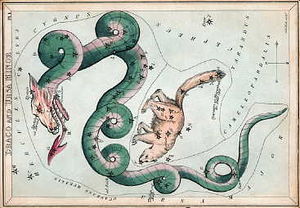Ursa Minor
| Constellation | |
List of stars in Ursa Minor |
|
| Abbreviation | UMi |
|---|---|
| Genitive | Ursae Minoris |
| Pronunciation | /ˌɜrsə ˈmaɪnər/, genitive /ˌɜrsiː mɨˈnɒrɨs/ |
| Symbolism | The Little Bear |
| Right ascension | 15 h |
| Declination | +75° |
| Quadrant | NQ3 |
| Area | 256 sq. deg. (56th) |
| Main stars | 7 |
| Bayer/Flamsteed stars |
23 |
| Stars with planets | 1 |
| Stars brighter than 3.00m | 3 |
| Stars within 10.00 pc (32.62 ly) | 0 |
| Brightest star | Polaris (1.97m) |
| Nearest star | UU UMi (42.60 ly, 13.06 pc) |
| Messier objects | 0 |
| Meteor showers | Ursids |
| Bordering constellations |
Draco Camelopardalis Cepheus |
| Visible at latitudes between +90° and −10°. Best visible at 21:00 (9 p.m.) during the month of June. |
|
Ursa Minor (Latin: "Smaller Bear", contrasting with Ursa Major), also known as the Little Bear, is a constellation in the northern sky. Like the Great Bear, the tail of the Little Bear may also be seen as the handle of a ladle, whence the name Little Dipper. It was one of the 48 constellations listed by the 2nd century astronomer Ptolemy, and remains one of the 88 modern constellations. Ursa Minor is notable as the location of the north celestial pole, although this will change after some centuries due to the precession of the equinoxes.[1]
Contents |
Notable features
Stars
Ursa Minor is colloquially known as the Little Dipper because its seven brightest stars seem to form the shape of a dipper (ladle or scoop). The star at the end of the dipper handle is Polaris, the North Star. Polaris can also be found by following a line through the two stars which form the end of the "bowl" of the Big Dipper, a nearby asterism found in the constellation Ursa Major.
Polaris (α UMi), the brightest star in the constellation, is a yellow supergiant shining at 2.02 apparent magnitude . It belongs to the rare class of Cepheid variable stars. Only a bit less bright is β UMi (Kochab), a 2.08 orange giant star.
The four stars in the "bowl" of the little dipper are unusual in that they are of second, third, fourth and fifth magnitude. Hence they provide an easy guide to determining what magnitude stars are visible, useful for city dwellers or testing your eyesight.
Named stars
| Proper Name |
Bayer Designation |
Apparent Magnitude |
Distance (LY) |
|---|---|---|---|
| Polaris | α UMi | 2.02 | 430 |
| Kochab | β UMi | 2.07 | 126 |
| Pherkad | γ UMi | 3.00 | 480 |
| Yildun | δ UMi | 4.85 | 185 |
| Urodelus | ε UMi | 4.21 | 347 |
| Ahfa al Farkadain | ζ UMi | 4.32 | 376 |
| Anwar al Farkadain | η UMi | 4.95 | 97 |
Deep sky objects
Ursa Minor Dwarf, a dwarf galaxy, is located in the area of the constellation.
History and mythology

Ursa Minor is commonly visualized as a baby bear with an unusually long tail. The tail was said to have been lengthened from that usually expected for a bear, due to its being held by the tail and spun around the pole.(The center of the sky)
Ursa Minor and Ursa Major were related by the Greeks to the myth of Callisto and Arcas. However, in a variant of the story, in which it is Boötes that represents Arcas, Ursa Minor was considered to represent a dog. This is the older tradition which sensibly explains both the length of the tail and the obsolete alternate name of Cynosura (the dog's tail) for Polaris, the North Star.[2]
Previously, Ursa Minor was considered to be just seven close stars, mythologically regarded as sisters. In early Greek mythology, the seven stars of the Little Dipper were considered to be the Hesperides, daughters of Atlas. Together with the nearby constellations of Boötes, Ursa Major, and Draco, it may have formed the origin of the myth of the apples of the Hesperides, which forms part of the Labours of Hercules.
In earliest times, Ursa Minor was named the Dragon's wing, and was considered a part of Draco. The dragon's wing as an asterism is now long forgotten.
In other cultures, Ursa Minor was the hole in which the Earth's axle found its bearing. In Hindu mythology, the Pole Star is Dhruva (the word means "pole" today), and there is a story behind him becoming a star.{i {Fact|date=December 2008}}
In Hungarian mythology the constellation's called 'Little Goncol cart' (Göncöl szekér) after a legendary shaman (Ursa Major is 'Big Goncol cart'). His knowledge knew no limit; he invented the cart: his nation was wandering, cart was the biggest present of the Gods to them. Legends claim he knew everything on the world. Nobody saw his death, his body disappeared among the stars.
See also
- Ursa Major
- Ursa Minor Beta, a place in The Hitchhiker's Guide to the Galaxy
Citations
References
- Ian Ridpath and Wil Tirion (2007). Stars and Planets Guide, Collins, London. ISBN 978-0007251209. Princeton University Press, Princeton. ISBN 978-0691135564.
External links
|
||||||||||||||
|
|||||
|
||||||||||||||||||||||||||||||||